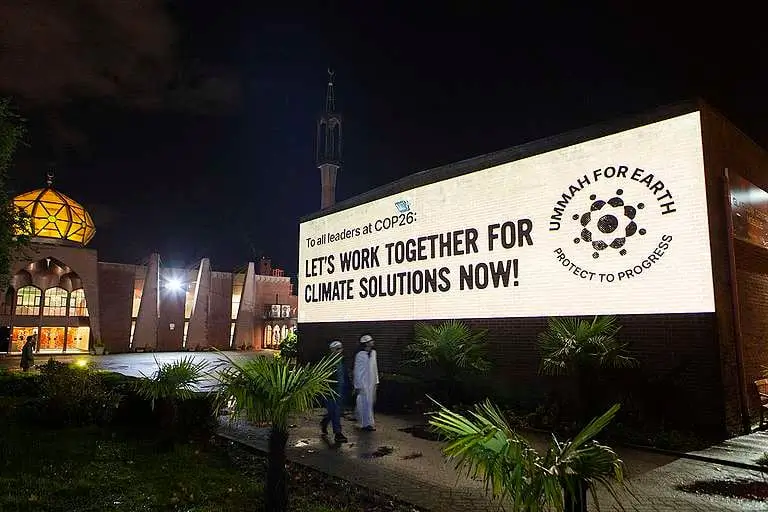Climate Finance and the Muslim World: An Assessment of Current Efforts
1. Introduction
Climate change poses a significant threat to global stability and prosperity, necessitating substantial financial resources to mitigate its effects and facilitate adaptation (Richardson, 2009). The Muslim world, comprising nations with diverse economic landscapes and varying vulnerabilities to climate change, faces unique challenges and opportunities in addressing this global crisis (Setyowati, 2020).
The urgency of climate action is underscored by the increasing frequency and intensity of extreme weather events, sea-level rise, and disruptions to agricultural systems, all of which disproportionately impact vulnerable populations within Muslim-majority countries. The mobilization of climate finance is therefore essential to support these nations in their efforts to transition to low-carbon economies, build resilience to climate impacts, and achieve sustainable development goals (Alcayna, 2020).
Islamic finance, with its ethical underpinnings and emphasis on social responsibility, offers a potentially powerful tool for channeling investments towards climate-friendly projects and initiatives (Obaidullah, 2017).
This approach aligns with the core values of Islam, which promote environmental stewardship, justice, and the well-being of future generations (Al‐Roubaie & Sarea, 2019).
By exploring the potential of Islamic financial instruments such as green sukuk and waqf, as well as examining the specific challenges and opportunities in regions like Somalia and East Africa, we can gain valuable insights into the role of the Muslim world in tackling climate change and advancing a more sustainable future for all.
The investigation into the role of Islamic finance within the context of climate change underscores the necessity of comprehending the existing landscape of climate finance flows to Muslim-majority countries, encompassing both public and private sources, in order to pinpoint the gaps and opportunities for enhanced engagement. The global Islamic finance assets have witnessed substantial growth, reaching $2.5 trillion in 2018 and projected to reach $3.4 trillion by 2024, presenting a significant pool of capital that could be strategically directed towards climate-related projects (Akhter et al., 2019). It is crucial to evaluate the extent to which these resources are currently being allocated to climate mitigation and adaptation efforts within the Muslim world, considering the diverse needs and priorities of individual nations. Several studies suggest that Islamic finance can contribute to and support the implementation of the SDGs (Harahap et al., 2023).
Furthermore, it is important to analyze the effectiveness of existing climate finance mechanisms in addressing the specific vulnerabilities and developmental challenges faced by Muslim-majority countries, taking into account factors such as governance, institutional capacity, and access to technology. Countries with predominantly Muslim populations often grapple with unique socio-economic and political contexts, which can influence their ability to access and effectively utilize climate finance.
2. The Climate Finance Imperative in Islamic Countries
The urgency of addressing climate change within the Muslim world is underscored by the region’s heightened vulnerability to its adverse effects, which include rising sea levels, desertification, and extreme weather events, all of which pose significant threats to both human populations and economic stability. These vulnerabilities are further compounded by factors such as rapid urbanization, water scarcity, and reliance on climate-sensitive sectors like agriculture, making climate finance a crucial tool for building resilience and fostering sustainable development. The current levels of climate finance flowing to Muslim-majority countries are inadequate to meet the scale of the challenge, highlighting the need for innovative financing mechanisms and enhanced international cooperation to bridge the gap. Islamic finance principles, rooted in ethical and socially responsible investing, offer a unique framework for mobilizing resources towards climate-friendly projects, aligning financial goals with the broader objectives of environmental stewardship and social justice.

The exploration of Islamic finance mechanisms, such as green sukuk and waqf, holds the potential to unlock new avenues for funding climate mitigation and adaptation initiatives within the Muslim world, thereby making significant contributions to the realization of sustainable development goals. Green sukuk, which are Shariah-compliant bonds used to finance environmentally friendly projects, have gained traction as a means of attracting investment in renewable energy, sustainable transportation, and other climate-related sectors (Edmark & Persson, 2021). Several countries are recognizing the segment’s potential, with authorities encouraging Islamic finance to improve financial inclusion (“The Core Principles for Islamic Finance Regulations and Assessment Methodology,” 2018). Waqf, an Islamic endowment that dedicates assets for charitable purposes, can be utilized to support long-term climate resilience projects, such as reforestation, water conservation, and disaster preparedness programs. It is imperative to critically assess the potential and limitations of these instruments, considering factors such as regulatory frameworks, investor awareness, and the availability of viable green projects.
3. Islamic Finance Instruments: Potential and Implementation
Green Sukuk, characterized as Shariah-compliant bonds earmarked for environmentally conscious projects, have surfaced as a compelling avenue for channeling investments towards climate mitigation and adaptation initiatives within the Muslim world (Fitrah & Soemitra, 2022). They provide a platform for governments and corporations to raise capital for green projects while adhering to Islamic finance principles, attracting a growing pool of ethically motivated investors.
The issuance of green sukuk has witnessed significant growth in recent years, with notable examples from countries like Malaysia, Indonesia, and the United Arab Emirates, demonstrating the viability and appeal of this instrument. For example, Malaysia debuted the first green sukuk and to date has the largest number of green sukuk issuances (“Pioneering the Green Sukuk,” 2020). Sovereign green sukuk funds were used to finance the green sector following maqahid shariah (Fitrah & Soemitra, 2022). Despite the growing interest in green sukuk, challenges remain in terms of standardization, transparency, and the availability of a robust pipeline of eligible projects.
Waqf, traditionally employed for charitable endowments within Islamic contexts, presents a distinctive avenue for fostering enduring climate resilience initiatives, encompassing reforestation endeavors, water conservation strategies, and proactive disaster preparedness programs.

By allocating Waqf assets towards these critical areas, communities can bolster their capacity to withstand climate-related shocks while simultaneously adhering to Islamic principles of social responsibility. The integration of Waqf principles into climate finance necessitates careful consideration of governance structures, project selection criteria, and the long-term sustainability of funded initiatives. The meticulous management and strategic deployment of Waqf assets are essential to ensure their enduring impact on climate resilience and community well-being, aligning financial resources with ethical considerations.
4. Case Studies: Climate Finance Initiatives in Somalia and East Africa
The East African region, particularly Somalia, exemplifies the urgent need for effective climate finance mechanisms to address the growing challenges posed by climate change, and climate finance initiatives must tackle these complicated issues. Somalia, with its arid and semi-arid landscapes, is highly vulnerable to droughts, floods, and desertification, which exacerbate food insecurity, displacement, and conflict (Fitrah & Soemitra, 2022). East Africa’s vulnerability to climate change is not uniform, with varying degrees of exposure and adaptive capacity across different regions and communities. The international community, including multilateral development banks, donor countries, and humanitarian organizations, has launched various climate finance initiatives in Somalia and East Africa, focusing on areas such as drought resilience, sustainable agriculture, and renewable energy. Innovative financial instruments can effectively mitigate various impacts of drought, but it is important to tailor the approach to the specific context (“A Rapid Review of Drought Risk Mitigation Measures,” 2021). Blended finance arrangements that bring together concessional public capital and private capital have been and will continue to be the means through which private finance supports many adaptation projects (“Innovative Financial Instruments and Their Potential to Finance Climate Change Adaptation in Developing Countries,” 2024).
However, the effectiveness of these initiatives is often hampered by factors such as limited access to finance, weak institutional capacity, and political instability, highlighting the need for more coordinated and targeted interventions. Devolved Climate Finance can be useful since local communities possess extensive knowledge of climate variability and associated risks (Patnaik, 2021). Further investigations are needed to assess the impacts of climate change.
5. Filling the Funding Gap: Challenges and Opportunities
Addressing the climate finance gap in the Muslim world requires a multifaceted approach that leverages both conventional and Islamic finance mechanisms, while also addressing systemic challenges that hinder effective resource mobilization and deployment. The Muslim world requires considerable investments in environmental and climate economics and a better understanding of the different vulnerabilities and their economic implications. Several developing countries are especially vulnerable to extreme weather events and natural disasters (Infrastructure for a Climate-Resilient Future, 2024). These events often lead to significant economic losses, which can set back development progress. Enhancing access to climate finance for vulnerable countries, such as Somalia, requires addressing barriers related to eligibility criteria, application processes, and project development capacity.
Furthermore, strengthening institutional capacity and governance structures is essential to ensure that climate finance is used effectively and transparently. Developed countries have a moral obligation to financially support the most vulnerable countries to adapt to climate change. Given the close relationship between development and adaptation, it is tempting to use existing channels of development assistance to fill this gap (Ayers & Huq, 2009). This is in contrast to the political narrative in the emerging climate finance architecture. Looking out into the future, the findings underscore the practical and political challenges in relation to a vulnerability-oriented prioritization of funding and they point towards the need to increase countries’ capacities to attract and manage international adaptation support (Doshi & Garschagen, 2020).
Ultimately, addressing the climate finance gap in the Muslim world requires a concerted effort from governments, financial institutions, civil society organizations, and the international community, guided by the principles of Islamic finance and sustainable development.
Negotiations historically focused on public funding from developed to developing countries and this funding is vital, particularly for the poorest and most vulnerable developing countries, but is only part of the picture (Thwaites et al., 2018). Mobilizing private sources of finance is also crucial.
Unless adaptation is rethought, transformation may also worsen vulnerability (Eriksen et al., 2021). Adaptation to climate change is dependent on current adaptive capacity and the development models that are being pursued by developing countries (Mirza, 2003). In contrast to previous research, donors partially take recipient country vulnerability into account when allocating adaptation finance and that countries that are more physically exposed are more likely to receive more aid on a per capita basis, as are low-income countries and SIDS (Robinson et al., 2023).
6. Conclusion
In conclusion, while there have been notable efforts to mobilize climate finance in the Muslim world, there is still a significant gap between the financial resources available and the investments needed to address the growing challenges posed by climate change. Islamic finance instruments, such as green Sukuk and Waqf, hold promise for filling critical funding gaps, particularly in areas such as renewable energy, sustainable agriculture, and climate-resilient infrastructure. However, realizing the full potential of these instruments requires addressing challenges related to standardization, regulation, and investor awareness.
The utilization of Islamic social finance, namely zakat, sukuk, waqf or sadaqah, has been proposed to have the potential to reduce the huge financial gap that exists in humanitarian financing (Ramli et al., 2018). Zakat and waqf should be delivered to Maqasid sectors that are related to shari’ah compliance (Budiman et al., 2021).
In the specific context of Somalia and East Africa, climate finance interventions must be tailored to address the unique vulnerabilities and development challenges facing these regions, with a focus on building resilience to drought, promoting sustainable livelihoods, and strengthening institutional capacity.
Moving forward, enhanced collaboration, innovation, and knowledge-sharing are essential to accelerate the mobilization and deployment of climate finance in the Muslim world, ensuring a more sustainable and resilient future for all.

